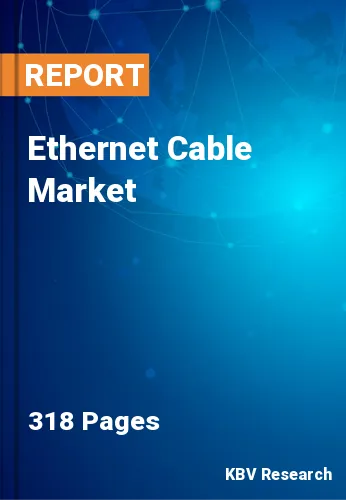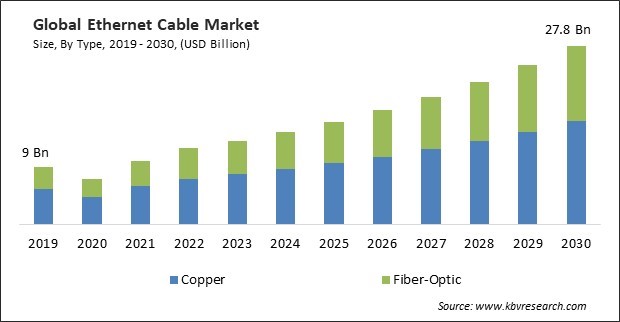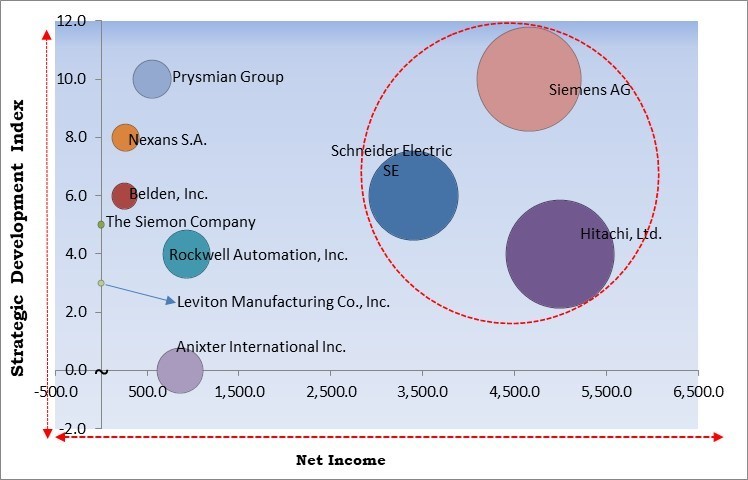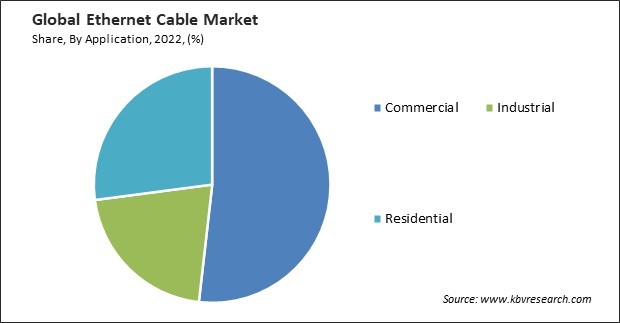
The Global Ethernet Cable Market size is expected to reach $27.8 billion by 2030, rising at a market growth of 11.4% CAGR during the forecast period. In the year 2022, the market attained a volume of 6,621.3 million meter, experiencing a growth of 11.0% (2019-2022).
Ethernet cables provide a reliable, high-speed communication infrastructure, allowing for seamless data transmission within industrial processes. Therefore, the industrial segment acquired $2,510.3 million in 2022. Ethernet cables connect programmable logic controllers (PLCs), Human-Machine Interfaces (HMIs), and sensors in factory automation systems. This connectivity enables precise control of manufacturing processes, reducing errors, and improving efficiency. The adoption of industrial ethernet protocols, such as PROFINET, EtherCAT, and Modbus TCP, has driven the demand for ethernet cables. These protocols enhance communication reliability and speed, making them suitable for various industrial applications.

The major strategies followed by the market participants are Partnerships as the key developmental strategy to keep pace with the changing demands of end users. For instance, In, August, 2023, Belden, Inc. came into partnership with Tubbesing, the partnership expands Belden's customer base. Additionally, In, April, 2023, Siemens AG partnered with IBM, the partnership would allow the joint customers of the two companies to reduce their operational costs and drive operational efficiencies.
Based on the Analysis presented in the KBV Cardinal matrix; Hitachi, Ltd., Siemens AG and Schneider Electric SEare the forerunners in the Ethernet Cable Market. In June, 2022, Hitachi, Ltd. partnered with Schneider Electric, an energy management and automation solutions provider, to provide energy transition solutions to their joint customers. The customers would benefit from a strengthened supply chain and improved efficiencies. Companies such as Rockwell Automation, Inc., Prysmian Group and Nexans S.A. are some of the key innovators in Ethernet Cable Market.

High-speed internet access, often delivered through cable or DSL connections, requires ethernet cables for connecting modems and routers to customer premises equipment. As more households and businesses seek faster internet access, the demand for ethernet cables in these setups has grown significantly. Fiber-optic ethernet cables have become preferred for delivering gigabit and multi-gigabit internet speeds to homes and businesses. As telecom and internet service providers (ISPs) invest in FTTH and FTTP infrastructure, the demand for fiber-optic ethernet cables has surged. Ethernet cables connect Wi-Fi access points and routers, enabling high-speed wireless internet in homes, offices, and public spaces. The proliferation of Wi-Fi networks has driven demand for ethernet cabling to provide reliable internet connectivity. The growth of these networks drives the demand for high capacity ethernet cabling. The increasing demand for high-speed internet expands the market growth.
Green ethernet cables are engineered to consume less energy during operation. They often incorporate energy-efficient components like low-power transceivers and advanced power-saving features. This increased energy efficiency aligns with global efforts to reduce energy consumption in networking infrastructure. Energy-efficient ethernet (EEE) technology in green cables helps reduce the carbon footprint of network operations. These cables lower greenhouse gas emissions by consuming less energy, making them attractive to environmentally conscious organizations and industries. Energy-efficient cables result in lower operational costs. Organizations can reduce their electricity bills by using green ethernet cables, which consume less power than conventional cables. This cost-saving benefit encourages the adoption of energy-efficient cabling solutions. This shift in consumer attitudes encourages the adoption of green ethernet cables. As environmental concerns continue to drive technological innovation and influence purchasing decisions, green ethernet cables are likely to remain a significant driver in the growth and evolution of the market.
The complexity of network management can be a barrier to adopting ethernet cables, especially for smaller businesses and organizations with limited IT resources. They may opt for simpler solutions or delay network expansion, impacting the demand for ethernet cables. Complex networks are more prone to misconfigurations and issues. Network downtime can result in substantial financial losses, discouraging organizations from making extensive Ethernet cabling investments. Maintaining complex ethernet cabling systems can be time-consuming and labor-intensive. Organizations may delay maintenance, leading to performance degradation and potential failures. The perceived complexity of network management can create uncertainty in the market, affecting the planning and deployment of Ethernet cabling projects. The above factors will hamper market growth in the coming years.
On the basis of application, the market is fragmented into industrial, commercial, and residential. The industrial segment garnered a significant revenue share in the market in 2022. Ethernet cables are integral to industrial automation systems, connecting programmable logic controllers (PLCs), sensors, actuators, and other devices to a central control system. These cables enable real-time data exchange, allowing for the automated control of machinery, production processes, and manufacturing lines. Ethernet cables are used for environmental monitoring in industrial settings, including air quality, emissions, and environmental compliance. Data collected can be transmitted to regulatory agencies and compliance systems.

By type, the market is segmented into copper and fiber-optic. In 2022, the copper cable segment dominated the market with the maximum revenue share. Copper Ethernet cables are generally more cost-effective compared to their fiber optic counterparts. They are affordable and widely available, making them attractive for many users, particularly in small to medium-sized networks and home setups. Copper Ethernet cables are relatively easy to install, especially in existing network infrastructures. They are flexible and can be bent and routed easily, making them suitable for various installation scenarios. Copper Ethernet cables are an excellent choice for short to medium-distance network connections, often exceeding the requirements of typical home and office networks.
Based on cable type, the market is classified into unshielded twisted pair and shielded twisted pair. In 2022, the unshielded twisted pair segment witnessed the largest revenue share in the market. Unshielded twisted pair (UTP) is a copper telecommunications cabling consisting of pairs of insulated copper wires twisted around each other. It is one of the most common and widely used cables for networking and communication purposes. UTP cables are cost-effective compared to other cables, making them popular for networking solutions. UTP cables are flexible and easy to install, making them suitable for various applications and environments. UTP cables are readily available and widely used, making them easy to source for networking projects. UTP cables are commonly used in networking applications for connecting computers, printers, routers, switches, and other devices. They are widely used for Ethernet networks, supporting data rates from 10 Mbps (Cat5e) to 10 Gbps and beyond (Cat6a).
| Report Attribute | Details |
|---|---|
| Market size value in 2022 | USD 11.9 Billion |
| Market size forecast in 2030 | USD 27.8 Billion |
| Base Year | 2022 |
| Historical Period | 2019 to 2021 |
| Forecast Period | 2023 to 2030 |
| Revenue Growth Rate | CAGR of 11.4% from 2023 to 2030 |
| Number of Pages | 318 |
| Number of Table | 653 |
| Quantitative Data | Volume in Million Meter, Revenue in USD Billion, and CAGR from 2019 to 2030 |
| Report coverage | Market Trends, Revenue Estimation and Forecast, Segmentation Analysis, Regional and Country Breakdown, Competitive Landscape, Porter’s 5 Forces Analysis, Company Profiling, Companies Strategic Developments, SWOT Analysis, Winning Imperatives |
| Segments covered | Type, Cable Type, Application, Region |
| Country scope |
|
| Companies Included | Hitachi, Ltd., Rockwell Automation, Inc., Schneider Electric SE, Belden, Inc., Prysmian Group, Nexans S.A., Anixter International Inc., Siemens AG, The Siemon Company, Leviton Manufacturing Co., Inc. |
| Growth Drivers |
|
| Restraints |
|
Region-wise, the market is analysed across North America, Europe, Asia Pacific, and LAMEA. In 2022, the North America region registered the highest revenue share in the market. The expansion of broadcast applications, the development of technologically advanced industries, and the heightened utilization of fiber optic cables have all contributed to the North American market’s growth in recent years. It is anticipated that technological advancements in the market and increased industrial demand for PoE will generate substantial growth opportunities for the market. During the forecast period, the expansion of the market in North America will be significantly propelled by the aforementioned factors.
Free Valuable Insights: Global Ethernet Cable Market size to reach USD 27.8 Billion by 2030
The market research report covers the analysis of key stake holders of the market. Key companies profiled in the report include Hitachi, Ltd., Rockwell Automation, Inc., Schneider Electric SE, Belden, Inc., Prysmian Group, Nexans S.A., Anixter International Inc., Siemens AG, The Siemon Company, Leviton Manufacturing Co., Inc.
By Type (Volume, Million Meter, USD Billion, 2019 to 2030)
By Application (Volume, Million Meter, USD Billion, 2019 to 2030)
By Cable Type (Volume, Million Meter, USD Billion, 2019 to 2030)
By Geography (Volume, Million Meter, USD Billion, 2019 to 2030)
This Market size is expected to reach $27.8 billion by 2030.
Increasing demand for high-speed internet are driving the Market in coming years, however, Complexity of network management restraints the growth of the Market.
Hitachi, Ltd., Rockwell Automation, Inc., Schneider Electric SE, Belden, Inc., Prysmian Group, Nexans S.A., Anixter International Inc., Siemens AG, The Siemon Company, Leviton Manufacturing Co., Inc.
In the year 2022, the market attained a volume of 6,621.3 million meter, experiencing a growth of 11.0% (2019-2022).
The Commercial segment is leading the Market by Application in 2022; thereby, achieving a market value of $12.4 billion by 2030.
The North America region dominated the Market by Region in 2022; thereby, achieving a market value of $9.4 billion by 2030.
Our team of dedicated experts can provide you with attractive expansion opportunities for your business.
